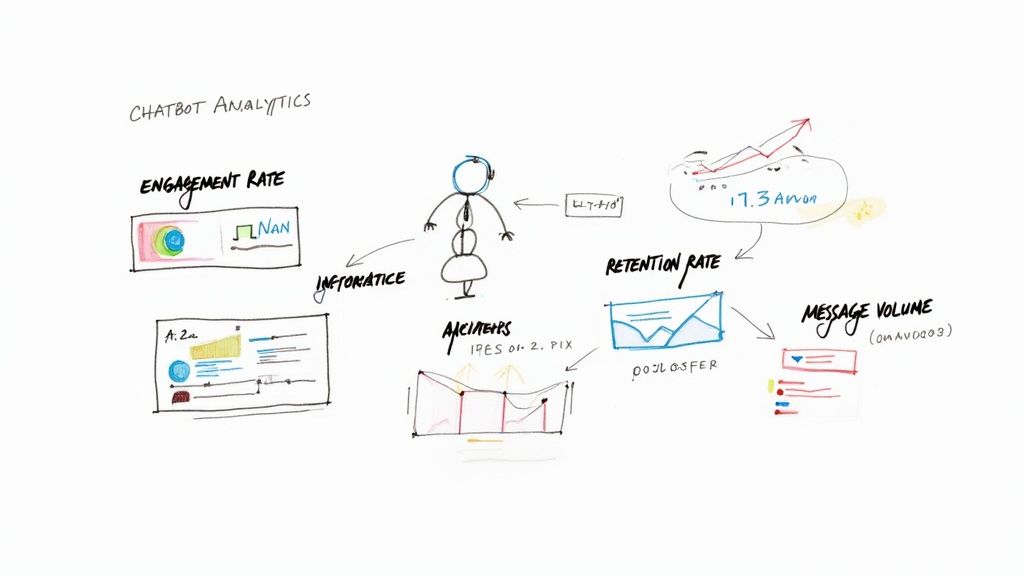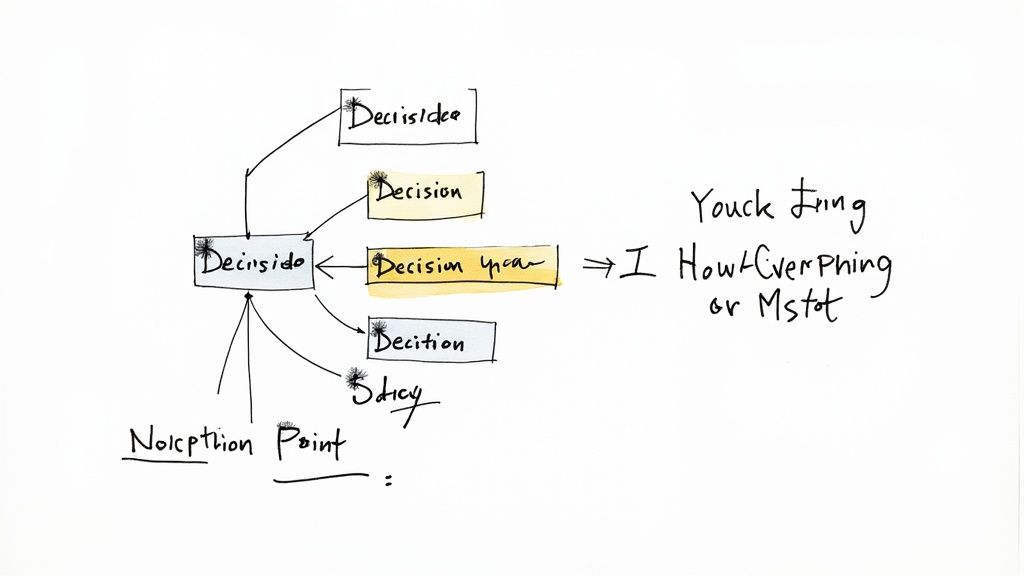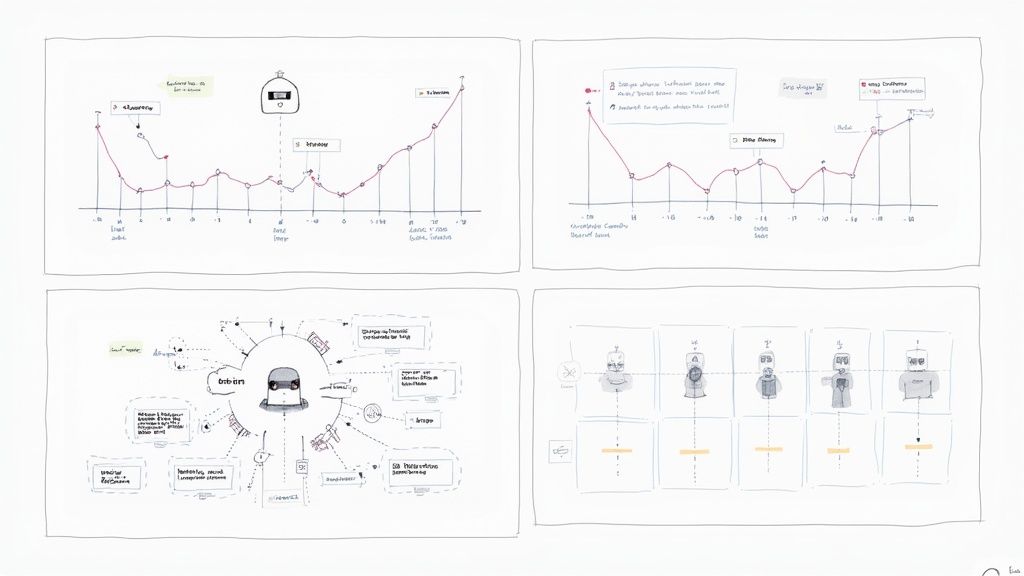Chatbot Analytics Guide: Optimize AI Performance
Understanding What Really Matters in Chatbot Performance

When evaluating your chatbot's performance, looking beyond basic metrics like total conversations is essential for getting meaningful insights. The real value comes from analyzing data that directly connects to your business objectives and customer experience. Let's explore the key performance indicators that help measure chatbot effectiveness and how to use this data to make smart improvements.
Key Metrics for Measuring Chatbot Success
While tracking total conversations provides a basic overview, this number alone can be misleading. For example, a high volume of chats might seem good at first glance, but if those interactions end in frustration or require frequent human intervention, your chatbot isn't serving its purpose effectively. Here are the metrics that paint a clearer picture:
- Goal Completion Rate: This shows how often users achieve their intended outcome, such as making a purchase or getting an answer to their question. It's a direct measure of whether your chatbot is helping customers succeed.
- User Satisfaction: Direct feedback through post-chat surveys and sentiment analysis tells you how customers really feel. Happy users are more likely to return and recommend your service to others.
- Fallback Rate: This reveals how often your chatbot fails to understand queries and needs human backup. A high rate points to gaps in your chatbot's language processing abilities that need attention.
- Average Conversation Length: The duration of chats can uncover important patterns. Quick chats with low completion rates may mean your bot isn't understanding users well. On the flip hand, very long conversations could show your bot is taking too many steps to help users reach their goals.
Interpreting Chatbot Analytics Data
Making sense of these metrics is key to improving your chatbot's performance. When you notice a high fallback rate in certain conversation types, it highlights specific areas where your chatbot needs better training or expanded knowledge. By analyzing user feedback alongside chat duration, you can spot friction points in conversations. This insight helps you know exactly where to make improvements - like simplifying complex exchanges or adding clearer response options.
Building a Data-Driven Chatbot Strategy with Sitebot
Sitebot, powered by GPT-4, gives you the tools to track and analyze these important metrics. The platform helps you identify what's working well and what needs improvement in your chatbot conversations. You can monitor user engagement patterns and use that data to make your chatbot more helpful and personal.
Sitebot turns raw analytics into clear action steps for making your chatbot better. Remember - success comes from paying attention to meaningful metrics, understanding what the data is telling you, and constantly fine-tuning based on those insights. This focused approach helps ensure your chatbot truly supports your business goals while providing excellent service to your customers.
Cracking the Code of User Engagement
Looking at chatbot performance requires going beyond basic metrics like conversation counts. The real insights come from a deeper understanding of user behavior - not just what users do, but why they make certain choices and how they feel during interactions. By carefully examining these patterns and signals, you can turn casual chatbot users into dedicated fans who keep coming back.
Understanding User Behavior Through Chatbot Analytics
Good chatbot analytics help reveal the reasoning behind user actions. Take goal completion rate as an example - this key metric shows how well your chatbot helps users accomplish what they set out to do. When completion rates are low, it often points to specific friction points in conversations that need fixing, either through adjusting the chat flow or improving the training data. The context becomes even clearer when you look at conversation length alongside completion rates. Quick conversations with low completion could mean the chatbot isn't meeting user needs, while drawn-out chats might indicate overly complex processes. For more insights, check out: How to master...
Measuring Genuine Engagement
Real engagement means users are actively participating and having a good experience, not just clicking through menus. Basic metrics like total conversations give you a starting point, but you need more to get the full picture. User satisfaction surveys, sentiment tracking, and feedback collection help gauge true engagement levels. For instance, sentiment analysis reveals the emotional tone in user messages - so even if a chat seems successful based on length or completion, underlying frustration might still be present. This feedback helps you fine-tune your chatbot's personality and responses to better match what users expect.
Turning Insights into Actionable Improvements
Gathering data is just the first step - the real value comes from using those insights to make concrete improvements. By spotting patterns in where users drop off or what questions keep coming up, you can zero in on areas that need work right away. For example, if your chatbot frequently needs human help (high fallback rate), that shows where the natural language processing needs strengthening. You might need to add more varied training data or adjust how the chatbot handles specific situations. Keep testing, adjusting, and measuring results to steadily improve performance and keep users engaged.
Utilizing Chatbot Analytics Platforms
Tools like Sitebot offer robust analytics features for monitoring chatbot performance. These platforms typically include real-time dashboards, custom reporting options, and connections to other business tools. This gives you a complete view of how your chatbot is doing, letting you track important metrics and spot trends as they emerge. Many platforms also offer advanced features like sentiment tracking and user grouping to better understand different customer segments. Taking this data-driven approach helps ensure your chatbot stays effective at engaging users while meeting your business goals.
Making Your Investment Count: ROI and Cost Analysis

When measuring chatbot performance, the bottom line matters just as much as user engagement metrics. You need a clear understanding of both the costs and financial benefits to determine if your chatbot is delivering real business value. Let's explore practical ways to calculate and improve ROI while balancing expenses with quality.
Calculating the ROI of Your Chatbot
Getting a complete picture of chatbot ROI requires looking beyond just the initial platform costs. You'll need to account for ongoing expenses like regular maintenance, updating training data sets, and connecting the chatbot with your existing business systems.
The benefits side of the equation includes measurable gains like reduced customer service expenses through automation, better sales conversion rates from personalized product recommendations, and faster workflows that save staff time. Compare key metrics from before and after implementing your chatbot - things like average resolution time for support tickets, sales conversion percentages, and number of qualified leads generated.
Identifying and Managing Cost Drivers
After establishing your core metrics, examine what drives your chatbot costs. The natural language processing (NLP) capabilities play a big role - more advanced NLP allows for nuanced conversations but costs more to run. Another major factor is conversation volume, particularly if you pay per chat interaction. For example, handling lots of basic questions may work fine with a simpler rule-based chatbot, while complex issues requiring human backup could justify investing in more sophisticated AI technology despite higher costs.
Optimization Strategies for Chatbot ROI
Getting the best ROI means finding the sweet spot between costs and performance. Use your chatbot analytics to spot where users frequently hit dead ends due to misunderstood queries. Focus your training data improvements on these specific weak points to reduce how often staff need to step in. You can also streamline conversation paths so users reach their goals in fewer steps - this improves satisfaction while potentially lowering per-interaction charges. Consider adding automated responses for common questions to efficiently handle high volumes of simple requests. By consistently analyzing the data and making targeted improvements, you'll maximize returns on your chatbot investment over time.
Building a High-Performance Chatbot Engine
Creating an excellent chatbot requires methodical refinement and testing. Like a skilled mechanic constantly adjusting an engine's performance, chatbot developers must carefully monitor, test and improve their systems. This process involves examining every interaction, from how well the bot understands users to how smoothly conversations flow. Success comes from finding and fixing bottlenecks, reducing errors, and making responses more accurate.
Analyzing Conversation Flows
Understanding how users interact with your chatbot starts with mapping conversation flows. Think of these flows like paths through a maze - if the route is unclear, users will get lost and give up. Clear analytics help identify where people get stuck, confused, or need human help. For instance, if many users abandon conversations at a specific point, that's a clear signal something needs to be fixed. This focused approach helps improve the parts of conversations that matter most.
Optimizing Response Patterns
Fine-tuning chatbot responses works like conducting an orchestra - every element must work together perfectly for the best result. The bot's replies need to match user questions precisely to keep conversations flowing smoothly. Analytics reveal which responses work well and which cause problems. This allows responses to be refined for clarity and accuracy, reducing the need for users to repeat themselves. Personal touches in responses, based on individual user needs, can also make conversations feel more natural. Learn more in our article about How to master chatbot building.
Implementing Continuous Improvements
Making a chatbot better is an ongoing process, not a one-time task. Like a gardener constantly tending their plants, chatbot developers must regularly check performance and make adjustments. Key metrics like completion rates, error rates, and user satisfaction need constant monitoring. This helps spot emerging issues early. For example, if error rates start climbing, it may mean the bot needs retraining or updates to better understand users.
Reducing Human Takeover While Maintaining Satisfaction
Finding the right mix of automation and human support is crucial for chatbots. While automating more tasks is the goal, some situations will always need human help. Analytics show exactly when and why human agents step in. By studying these cases, developers can expand what the chatbot handles well. This might mean adding training data, improving language processing, or building new features for specific needs. Over time, this reduces how often humans need to help while keeping users happy. The result is a more capable chatbot that consistently delivers good experiences.

Advanced Analytics Techniques for Better Chatbot Performance

Basic metrics like goal completion and fallback rates provide a good foundation, but taking your chatbot analytics to the next level reveals deeper insights into user behavior. Moving beyond simple tracking of what happened to understanding why it happened - and predicting what will happen next - allows companies to proactively improve their chatbots and create better experiences for users.
Predictive Analytics: Getting Ahead of User Needs
By analyzing historical chatbot data with machine learning and statistical methods, you can start to forecast how users will behave. This could be as straightforward as identifying peak usage times to staff appropriately, or as nuanced as suggesting relevant products based on a user's past conversations. For example, if someone previously asked about a specific item, the chatbot can automatically recommend related products during their next chat. This personal touch tends to boost sales and satisfaction.
Sentiment Analysis: Reading Between the Lines
Looking at the emotional tone of messages gives you insights that raw metrics miss. A conversation might look successful on paper, but sentiment analysis can pick up on underlying frustration or confusion in how users express themselves. When negative emotions are detected, you can take action - perhaps by connecting users with a human agent or adjusting the chatbot's responses to be more empathetic. Over time, tracking sentiment helps shape the chatbot's communication style.
Cohort Analysis: Understanding Different User Groups
Breaking users into groups based on shared traits reveals important patterns in how they interact with your chatbot. Users who arrive through a marketing campaign often behave differently than those who find the chatbot organically. Some groups might prefer quick, direct answers while others engage better with a more conversational approach. Recognizing these differences lets you adapt the chatbot experience for each user segment.
Making Advanced Analytics Work
Setting up advanced analytics requires choosing the right mix of tools and expertise for your needs. While some chatbot platforms include analytics features, others work better with separate analytics tools. For guidance on selecting analytics solutions, check out our article on How to master chatbot analytics. Just remember to prioritize data privacy and security. You'll also need skilled analysts who can turn complex data patterns into practical improvements. When you combine powerful analytics tools with human insight, you create a cycle of continuous enhancement that keeps making your chatbot better.
Turning Insights into Action: Implementation Strategies
Moving from analytics to real improvements requires a systematic approach. This section explores practical ways to convert data insights into concrete changes that make your chatbot more effective and user-friendly.
Prioritizing Improvements Based on Chatbot Analytics
Just like a doctor triaging patients in an emergency room, you need to focus on the most critical issues first. Start by identifying which problems have the biggest impact on your core metrics. For instance, if your data shows users frequently abandon conversations during product inquiries, fixing those interaction flows should take priority over minor interface tweaks. By targeting high-impact areas first, you'll see meaningful improvements in user satisfaction and engagement.
A/B Testing: The Scientific Approach to Chatbot Optimization
A/B testing lets you measure the real impact of changes with confidence. Create two versions of your chatbot - version A stays the same while version B includes your proposed changes. For example, you might test whether a casual or formal greeting works better with users. By comparing metrics between the two versions, you can see exactly how each change affects user behavior and make decisions based on hard data rather than hunches.
Measuring the Impact of Implemented Changes
Once changes are live, careful measurement becomes essential. Track core metrics like completion rates and user satisfaction, but also dig deeper by analyzing different user segments. New visitors might respond differently than returning customers. Pay special attention to metrics that directly connect to your business goals - for example, if you're focused on sales, monitor conversion rates closely. This detailed analysis helps you understand what's working and what needs further adjustment.
Scaling Successful Improvements Across Your Chatbot System
After finding changes that work well, roll them out systematically across your entire chatbot. Start with a small subset of users to catch any issues early, then gradually expand. Keep detailed records of what changes you make and their results - this creates a valuable playbook for future improvements. Remember that scaling is about more than just copying what worked in one place; you need to adapt solutions thoughtfully for different contexts and user groups.
Managing the Improvement Process and Avoiding Common Pitfalls
Success requires careful management of the improvement process itself. Set clear goals and timelines, assign specific responsibilities to team members, and create checkpoints to review progress. Watch out for common mistakes like changing too many things at once (which makes it hard to identify what actually worked) or forgetting to inform key stakeholders about updates. Regular check-ins and clear communication help keep everyone aligned and moving toward better chatbot performance.
Ready to make your chatbot more effective? Sitebot, powered by GPT-4, gives you the analytics and tools you need to understand user behavior and make data-driven improvements that get results. Visit Sitebot today to start optimizing your chatbot's performance.

